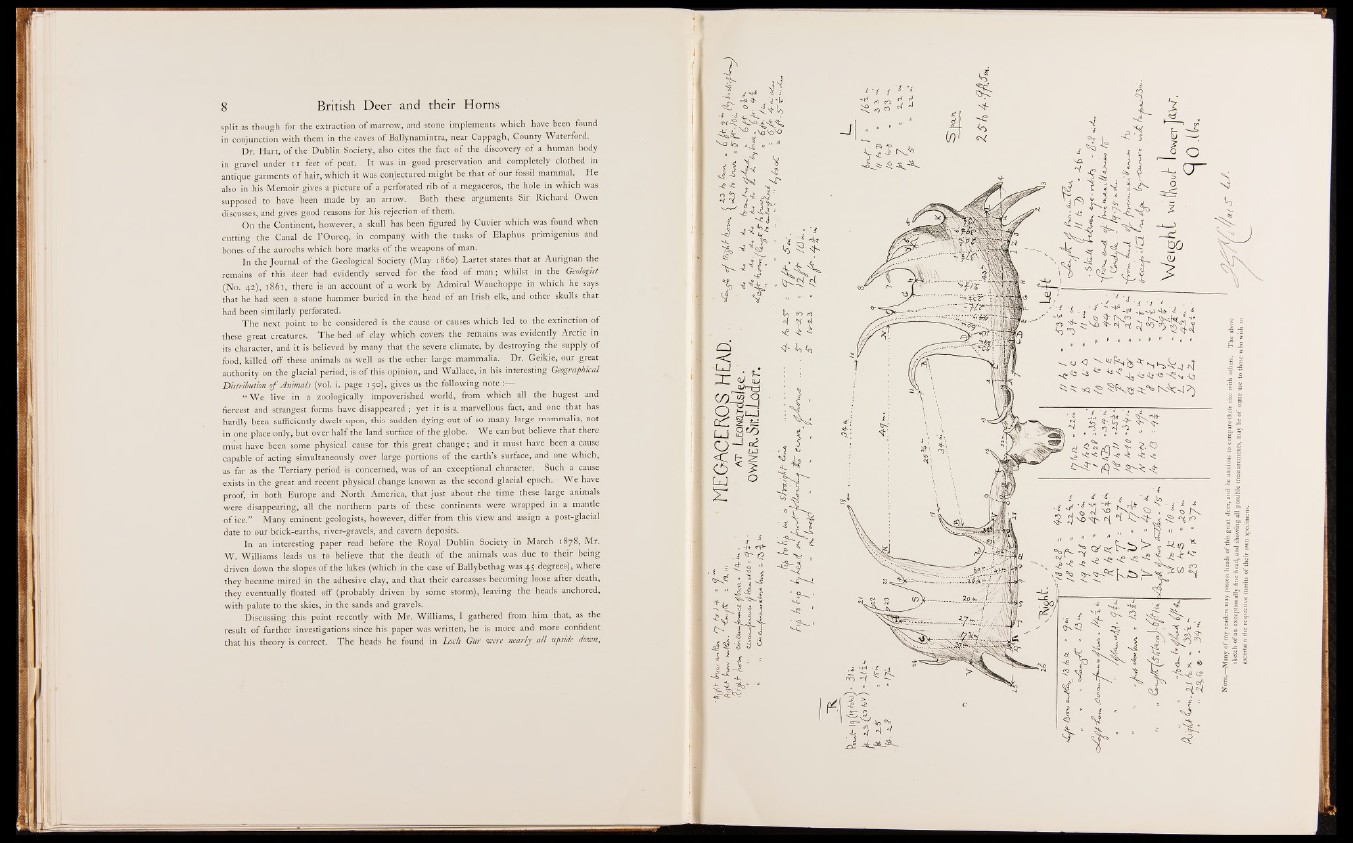
split as though for the extraction o f marrow, and stone implements which have been found
in conjunction with them in the caves o f Ballynamintra, near Cappagh, County Waterford.
Dr. Hart, o f the Dublin Society, also cites the fact o f the discovery o f a human body
in gravel under 11 feet o f peat. It was in good preservation and completely clothed in
antique garments o f hair, w hich it was conjectured might be that o f our fossil mammal. He
also in his Memoir gives a picture o f a perforated rib o f a megaceros, the hole in which was
supposed to have been made by an arrow. Both these arguments Sir Richard Owen
discusses, and gives good reasons for his rejection o f them.
On thé Continent, however, a skull has been figured by Cuvier which was found when
cutting the Canal de 1’Ourcq, in company with the tusks o f Elaphus primigenius and
bones o f the aurochs which bore marks o f the weapons o f man.
In the Journal o f the Geological Society (May i860) Lartet states that at Aurignan the
remains o f this deer had evidently served for the food o f man; whilst in the Geologist
(No. 42), 1861, there is an account o f a work by Admiral Wauchoppe in which he says
that he had seen a stone hammer buried in the head o f an Irish elk, and other skulls that
had been similarly perforated.
T h e next point to be considered is the cause or causes which led to the extinction o f
these great creatures. The bed o f clay which covers the remains was evidently Arctic in
its character, and it is believed by many that the severe climate, by destroying the supply o f
food, killed off these animals as well as the other large mammalia. Dr. Geikie, our great
authority on the glacial period, is o f this opinion, and Wallace, in his interesting Geographical
Distribution o f Animals (vol. i. page 150), gives us the following noten H |
“ W e live in a zoologically impoverished world, from which all the hugest and
fiercest and strangest forms have disappeared ; yet it is a marvellous fact, and one that has
hardly been sufficiently dwelt upon, this sudden dying out o f so many large mammalia, not
in one place only, but over half the land surface o f the globe. W e can but believe that there
must have been some physical cause for this great change; and it must have been a cause
capable o f acting simultaneously over large-portions o f the earth’s surface, and one which,
as far as the Tertiary period is concerned, was o f an exceptional character. Such a cause
exists in the great and recent physical change known as the second glacial epoch.- We have
proof, in both Europe and North America, that just about the time these large animals
were disappearing, all the northern parts o f these continents were wrapped in a mantle
o f ice.” Many eminent geologists, however, differ from this view and assign a post-glacial
date to our brick-earths, river-gravels, and cavern deposits.
In an interesting paper read before the Royal Dublin Society in March 1878, Mr.
W . Williams leads us to believe that the death o f the animals was due to their being
driven down the slopes o f the lakes (which in the case o f Ballybethag was 45 degrees), where
they became mired in the adhesive clay, and that their carcasses becoming loose after death,
they eventually floated off (probably driven by some storm), leaving the heads anchored,
with palate to the skies, in the sands and gravels.
Discussing this point recently with Mr. Williams, I gathered from him that, as the
result o f further investigations since his paper was written, he is more and more confident
that his theory is correct. T h e heads he found in Loch Gur were nearly all upside down,